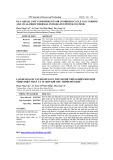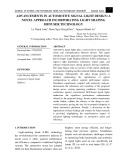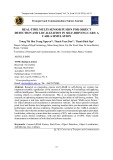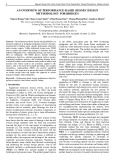
44 Tran Dang Khoa Phan, Van Thanh Vu
LORAWAN-BASED REMOTE MONITORING AND CONTROL SYSTEM FOR
CANAL GATES OF PADDY FIELD IRRIGATION SYSTEMS
Tran Dang Khoa Phan, Van Thanh Vu*
The University of Danang - University of Science and Technology, Vietnam
*Corresponding author: vvthanh@dut.udn.vn
(Received: July 29, 2024; Revised: October 02, 2024; Accepted: November 01, 2024)
DOI: 10.31130/ud-jst.2024.353E
Abstract - Irrigation systems are crucial for water management
in paddy fields, but manual operation of canal gates often results
in localized water shortages or excesses. Previous studies have
developed remote monitoring and control systems using Wi-Fi
and Internet protocols, but these approaches face difficulties
when applied to large-scale irrigation areas. This paper presents a
LoRaWAN-based remote monitoring and control system for
canal gates of paddy field irrigation systems. The proposed
system employs the LoRa technique to create a network of sensor
nodes that covers a wide geographical area, making it well-suited
for large irrigation systems. Unlike previous studies, which often
implemented small-scale models, this system was deployed in a
real-world setting in An Trach village, Da Nang. Experimental
results showed that the proposed system can transmit data over
distances up to 2 km and consumes less energy compared to the
MQTT-4G-based solutions, making it ideal for large-scale
irrigation systems.
Key words - LoRaWan; MQTT; IoT; Automatic water irrigation;
Smart irrigation
1. Introduction
Irrigation systems play an important role in water
management, ensuring field productivity. Currently, many
irrigation systems for paddy fields have been concreted,
helping to avoid water loss and ensure seasonal
availability. These systems are managed manually by the
field irrigation staff. Due to the limited number of
employees and large management area, combined with the
lack of management tools, the implementation of closing
and opening canal gates to regulate irrigation is not
synchronized, causing local water shortage or excess in
many places. Therefore, developing a remote monitoring
and control system for canal gates of paddy field irrigation
systems is essential to improve the efficiency of water
management.
The irrigation system consists of main canals and field
canals leading water to paddy fields. Canal gates are placed
in the canals to regulate the amount of water entering the
canals. For brevity, the gates in the main canals are called
main canal gates; and the gates in the field canals – field
canal gates. While the number of main canal gates is
limited, the number of field canal gates is very large. The
main canal gates are continuously controlled according to
the plan and through monitoring the water levels in front
and behind the gate, and the opening levels of the gates.
Meanwhile, the field canal gates are only opened and
closed on demand.
The remote monitoring and control systems for canal
gates of paddy field irrigation systems face the following
challenges. First, the paddy field irrigation system spread
over a large area, requiring the system to be able to transmit
and receive signals over long distances. Second, the power
supply to irrigation systems for paddy fields is limited,
leading to the problem of energy consumption of the
system that needs to be considered.
Sanjula et al. [1] proposed a system to control canal
gates of paddy fields irrigation systems based on sensor
nodes connected in a peer-to-peer network. A node plays
the main role in connecting to the Internet via Wi-Fi. Based
on information collected from the sensor nodes, canal gates
are opened or closed by a stepper motor. A PID algorithm
was used to control the motor to ensure the water flow into
the field. Desnanjaya and Nugraha [2] used a website
platform to control canal gates. The SIM module 900 was
used to transmit information to the database. The message
queuing telemetry transport (MQTT) protocol has been
widely used in many studies [3-5] to collect sensors data
and deliver it to the cloud or server through wireless
communication modules. Such an approach usually uses
4G modules to connect to the Internet. For brevity, we call
this protocol MQTT-4G. A direct motor control system
based on data from sensors was proposed in [6]. Liu et al.
[7] used NB-IoT (Narrowband Internet of Things) to
transmit data from sensors.
Although several solutions have been proposed to
remotely monitor and control canal gates of paddy field
irrigation systems, some limitations still exist. First, the
existing systems were mainly based on the Wi-Fi and
Internet communication protocols that are difficult to
deploy for paddy field irrigation systems, which spread
over a large area. These solutions are suitable mainly for
main canal gates, where data packets need to be exchanged
continuously in real time. However, it is difficult to deploy
for a large number of field canal gates due to the power
supply issue and operating costs (e.g., for Wi-Fi and 4G
payments). Second, the previous works only presented
small-sized models that are not close to reality.
In this paper, we present a remote monitoring and
control system for canal gates of paddy fields irrigation
systems. Unlike previous studies that consider solutions
that are suitable mainly for main canal gates, we focus on
a system that can be deployed for field canal gates, which
are in large quantities. While the main canal gates need to
operate in real time, the field canal gates only need to be
controlled on demand. However, field canal gates are
distributed over a large area and are often not powered

ISSN 1859-1531 - THE UNIVERSITY OF DANANG - JOURNAL OF SCIENCE AND TECHNOLOGY, VOL. 22, NO. 12, 2024 45
from the grid. Thus, we must consider problems related to
long-distance communication, power consumption, and
operating costs. Different from previous works, the system
is built based on LoRaWAN, which is a low-power wide-
area wireless network. The proposed design was
constructed and practically deployed to several canal gates
of the irrigation system in An Trach village, Hoa Tien
commune, Hoa Vang district, Da Nang city. Besides, we
also built a similar system but based on the MQTT-4G
protocol, which has been widely employed by many
previous studies for remote canal gate control. Experiments
were performed to evaluate the two systems based on
different quantitative criteria to show the effectiveness of
each system.
The main contributions of this paper are as follows.
First, a LoRaWAN-based remote monitoring and control
system for canal gates of paddy field irrigation systems is
proposed. The system ensures long-distance
communication, low power consumption, low operating
cost, suitable for deployment to a large number of field
canal gates. Second, a real-world system was constructed
and deployed in practice for experiments. Experimental
results showed the effectiveness of the proposed system.
Figure 1. Remote monitoring and control system for
canal gates of paddy field irrigation systems
2. Proposed system
2.1. General structure
In this section, we present the general structure of the
remote monitoring and control system for canal gates. The
system is built on a low-power wide-area wireless network
LoRaWAN, which allows communication between
devices over long distances and consumes low power [8].
The system includes LoRa nodes used to collect water level
data and control the canal gates (Figure 1). According to
the regulations of the Vietnam Ministry of Information and
Communications [9], the transceiver frequency range of
LoRa devices is set to 920 −923𝑀𝐻𝑧 and the
transmission power must be lower than 25𝑚𝑊. A LoRa
gateway is used to transmit and receive data with LoRa
nodes. It then converts the LoRa protocol into the IP
protocol to transmit data of LoRAWAN devices to the
Internet. An application on the website is built for users to
remotely monitor and control canal gates via LoRa server.
2.2. Lora node
LoRa nodes receive data from the water level sensors
and control the motors to open and close the canal gates.
Nodes are capable of transmitting and receiving data with
the LoRa gateway according to the LoRa protocol. The
block diagram of the LoRa node is depicted in Figure 2a.
The mechanical design of a canal gate and a LoRa node is
shown in Figure 2b.
(a)
(b)
Figure 2. (a) Block diagram of a LoRa node; and
(b) Mechanical design of a canal gate and a LoRa node
The LoRa nodes are configured to match Channel 3 of
the AS923 frequency diagram according to the regulations
of the Vietnam Ministry of Information and
Communications [9]. The details of parameter setting are
shown in Table 1. The format of packets transmitted from
LoRa nodes to the LoRa server are described in Table 2.
Table 1. Parameter setting of LoRa nodes
Parameter
Setting
Class
C
Frequency
921.4𝑀ℎ𝑧
SF (Spreading Factor)
SF12
BW (Bandwidth)
125𝑘𝐻𝑧
CR (Coding Rate)
4/5
Data transmission cycle
30 𝑚𝑖𝑛
Data reception cycle
Ready

46 Tran Dang Khoa Phan, Van Thanh Vu
Table 2. Packet format of LoRa nodes
Packet frame
Size
ID node
1 byte
Water level
2 bytes
Tension level
2 bytes
Power motor
2 bytes
State gate
1 byte
Volage of Battery
2 bytes
Duration of status sending
4 bytes
Duration of repeating packet
4 bytes
2.3. LoRa gateway
The LoRa gateway collects data from LoRa nodes. It is
connected to the LoRa server through the Internet using
Wi-Fi. The Lora gateway is built on an embedded
computer Raspberry Pi 4 and the Semtech's core SX1302
[10] (Figure 3a). The device has many advantages such as
scalability, multi-channel, large memory, and long-
distance transmission (up to 30km) [10].
(a)
(b)
Figure 3. LoRa gateway: (a) Block diagram;
and (b) Actual device
The LoRa gateway is connected to the Internet via Wi-
Fi provided by a 4G-to-wifi adapter. The gateway is always
connected to the power supply via a 5.1V - 3A adapter. The
data transmitted to the gateway is configured to forward to
the address http://203.205.43.93:8080/, which is a
LoRaWAN cloud built on the LoRa server using ChirpStack
[11]. Some libraries and tools used to build the gateway can
be accessed at https://github.com/Lora-net/sx1302_hal.git.
Figure 3b depicts the actual gateway that has been built.
2.4. LoRa server
The LoRa server receives and stores the data
transmitted from LoRa nodes through the LoRa gateway.
Besides, the LoRa server also transmits the control and
setting data from the user interface to LoRa nodes. The
LoRa server, which is based on ChirpStack [9], operates on
a computer with Ubuntu 22.02 LTS operating system. The
server is able to establish a proactive and private network.
ChirpStack itself provides a web interface for managing the
gateway and LoRa nodes and establishes data integration
with major vendors, databases, and cloud services
commonly used to process device data. ChirpStack also
provides a gRPC-based API that can be used to integrate or
extend ChirpStack.
2.5. Monitoring and control website
A website is designed as a GIS map for users to easily
manipulate and monitor. It connects data to the LoRa
server via MQTT protocol. The canal gate status, control
and setting data are displayed in the website’s interface
(Figure 4).
Figure 4. The interface of the monitoring and control website
3. Experimental results
3.1. Proposed system evaluation
In this section, we evaluate the proposed system in
terms of transmission capability. We deployed a real-world
system, which consists of three LoRa nodes and one LoRa
gateway, for the irrigation system in An Trach village, Hoa
Tien commune, Hoa Vang district, Da Nang city. The
LoRa nodes are arranged to ensure the condition of line-of-
sight propagation. It means that waves can only travel from
the source to the receiver in a direct visual path without
obstacles. This condition ensures that the signal loss is
mainly due to the distance and antennas. The distances
between the Lora nodes and the gateway are 1.3𝑘𝑚 ,
1.5𝑘𝑚 and 2.1𝑘𝑚. The GIS map showing the deployment
location of the LoRa nodes and the LoRa gateway is
demonstrated in Figure 5a. The deployed LoRa node with
a canal gate is shown in Figure 5b.
(a)
(b)
Figure 5. (a) The GIS map showing the deployment locations of
three LoRa nodes and one LoRa gateway in An Trach village,
Hoa Tien commune, Hoa Vang district, Da Nang city;
(b) Deployed LoRa node and canal gate
To evaluate the system's transmission capability, the
following criteria are used: RSSI (Received Signal Strength

ISSN 1859-1531 - THE UNIVERSITY OF DANANG - JOURNAL OF SCIENCE AND TECHNOLOGY, VOL. 22, NO. 12, 2024 47
Indication), SNR (Signal-to-Noise Ratio), and PDR (Packet
Delivery Ratio) [8]. The RSSI index measures the power
loss relative to the transmitter source and is calculated based
on the delivered power minus the total loss on the
transmission line. RSSI is measured in 𝑑𝐵𝑚 and has
negative values. The closer the RSSI value is to 0, the
stronger the received signal. The SNR index measures the
ratio between the received signal power and the noise power
and is expressed in 𝑑𝐵. The noise includes unwanted signal
sources that cause decoding difficulties at the receiver. If
SNR is greater than 0, the received signal will operate above
the noise floor. If SNR is less than 0, the received signal will
operate below the noise floor. The PDR index measures the
ratio of the number of packets successfully received to the
total number of packets transmitted [8]. PDR is an important
parameter to evaluate network stability.
To measure the above indices, 48 packets were
transmitted in a day. Table 3 shows the average RSSI, average
SNR, and PDR values for 48 packets transmitted in a day.
According to the datasheet of the Semtech’s module [10],
for the spreading factor of 12, the minimum SNR for
demodulation is −20𝑑𝐵. It can be seen from Table 3 that the
quality of the signal received at the gateway is guaranteed to
be demodulated. This also corresponds to PDR values of
100%. Table 3 also shows that, as the distance increases, the
average RSSI and SNR indices both decrease due to distance
attenuation. However, these indicators are still good enough
to ensure signal demodulation at the gateway.
Table 3. Average RSSI, average SNR, and PDR for
48 packets transmitted in a day
LoRa node
Distance
(km)
RSSI
(dBm)
SNR
(dB)
PDR
Node 1
1.3
− 94.7
1.52
48/48
Node 2
1.5
− 102.3
− 2.21
48/48
Node 3
2.1
− 135.1
− 6.33
48/48
3.2. Comparative study
Figure 6. The GIS map shows the deployment locations of
the MQTT-4G nodes
In this section, we compare the proposed system with the
MQTT-4G-based solution, which has been employed by
many studies [3-5]. The purpose of this comparative study is
to show the advantages and disadvantages of each solution
and the feasibility of applying it to a paddy field irrigation
system. To this end, we deployed an MQTT-4G-based
system which consists of two nodes. Each node has a similar
design to the LoRa node but using the MQTT-4G
transmission protocol. Besides, the MQTT-4G node uses the
module SIM7600CE instead of the module SX1276 like the
LoRa node. Two MQTT-4G nodes are arranged
independently as shown in Figure 6. The operating
parameters of the MQTT-4G nodes are described in Table 4.
Table 4. Operating parameters of the MQTT-4G nodes
Parameter
Setting
Frequency
4G (2500𝑀𝐻𝑧 − 2600𝑀𝐻𝑧)
Uplink
50𝑀𝑏𝑝𝑠
Downlink
150𝑀𝑏𝑝𝑠
Data transmission cycle
30 𝑚𝑖𝑛
Data reception cycle
Ready
For the MQTT-4G nodes, the packet format has a type of
string data. Thanks to the MQTT protocol, these nodes can
exchange data well even in the limited bandwidth condition.
The data is transmitted to the server according to topics
specified for each node. We measured the signal transmission
quality of the MQTT-4G based system to ensure comparative
experiments. Test results showed that the signal level during
the day is in the range from −60𝑑𝐵𝑚 to −71𝑑𝐵𝑚, which is
within the range of good to very good signal levels as
recommended by the network operator [12]. The PDR index
reached 100% for 48 packets transmitted in a day.
Figure 7. Flow chart of the algorithm to control the timing of
data transmission for both systems
To ensure fairness in comparison, we used the IC
DS3231 real-time clock to simultaneously trigger the data
transmission of both systems every 30 minutes. For control
data sent from the server, the website transmits randomly
to both systems simultaneously. To save energy, the
sensors as well as the motors are powered off using
MOSFETs and are only awakened to operate for a short
period of time before transmitting and receiving control
data. The algorithm to control the timing of data
transmission for both systems is shown in Figure 7.
The digital multimeter Keysight DMM 34460 [13] was
used to measure the power consumption of the two
systems. The energy dissipated by sensors, motors, and
drivers is ignored because they consume the same power
for both systems. Table 5 shows the average current and
duration for different tasks of both systems.

48 Tran Dang Khoa Phan, Van Thanh Vu
Table 5 shows that the initialization process of the
MQTT-4G-based system is longer and consumes more
energy than the LoRaWAN-based one. The reason is that
the initialization of the SIM 7600 module requires a lot of
time for SIM card reception and stable network connection
[14]. The LoRAWAN-based system takes about 5 times
longer than the MQTT-4G solution to transmit and receive
a packet. It is due to the fact that the data transfer speed of
LoRaWAN with the spreading factor of 12 is only about
250𝑏𝑝𝑠 [15] that is much slower than the uplink speed of
4𝑀𝑏𝑝𝑠 of the 4G SIM module [14]. To save energy, both
systems use the standby state. In this state, the proposed
system consumes much less energy than the system using
MQTT-4G. Note that the standby state is a task that
operates more frequently compared to other tasks.
Table 5. The average current and duration for different tasks of
the LoRaWAN-based and MQTT-4G-based systems
Task
LoRaWAN
MQTT-4G
Average
current
Average
duration
Average
current
Average
duration
Initialization
39mA
412ms
198mA
4000ms
Status packet
sending
129.5mA
1199ms
125mA
205ms
Packet listening
0.6mA
Always
80mA
Always
Receiving of
packet
99.0mA
786 ms
(randomly)
108.0mA
146ms
(randomly)
In summary, the experimental results showed that the
power consumption of the MQTT-4G-based system is much
higher than that of the LoRaWAN-based solution. However,
the time duration for data transmission and reception of the
proposed system is longer, which means that the control
signal response is slower than the system using MQTT-4G.
It can be seen that the LoRaWAN-based system is suitable
for field canal gates, which are controlled on demand. Besides,
the motors and drivers of field canal gates consume little
energy so the LoRa node can operate solely on solar energy.
Meanwhile, the MQTT-4G solution allows for real-time data
packet exchange, compatible with the main canal gates.
Additionally, compared with the LoRaWAN-based approach,
the MQTT-4G solution has higher operating costs due to the
high-cost SIM modules and monthly SIM card payments.
Therefore, this solution is not suitable for deployment to a
large number of field canal gates.
4. Conclusion
In this paper, we presented the LoRaWAN-based remote
monitoring and control system for canal gates of paddy field
irrigation systems. Unlike other studies that employed the Wi-
Fi and Internet protocols to exchange data, the proposed
system uses the LoRa communication technique. The system
includes the LoRa nodes that collect data from sensors and
communicate with the LoRa gateway. The server is built to
store data and communicate with users through the website.
While previous studies only implemented small-sized models
for experiments, we deployed the real-world system in An
Trach village, Hoa Tien commune, Hoa Vang district, Da
Nang city. Experiments have been conducted to evaluate the
quality of data transmission, and power consumption of the
proposed system. We also built a similar system but based on
the MQTT-4G protocol to compare with the proposed system.
Experimental results show that the LoRaWAN-based system
is suitable for monitoring and controlling field canal gates,
while the MQTT-4G solution is suited to main canal gates.
Acknowledgement: This work was supported by The
Murata Science Foundation and The University of Danang
- University of Science and Technology, code number of
Project: T2023-02-07MSF.
REFERENCES
[1] W. A. K. L. Sanjula, K. T. W. Kavinda, M. A. K. Malintha, W. M. D.
L. Wijesuriya, S. Lokuliyana, and R. de Silva, "Automated Water-Gate
Controlling System for Paddy Fields”, 2020 2nd International
Conference on Advancements in Computing (ICAC), Malabe, Sri
Lanka, 2020, pp. 61-66, doi: 10.1109/ICAC51239.2020.9357312.
[2] I. G. M. N. Desnanjaya and I. M. A. Nugraha, "Design and Control
System of Sluice Gate With Web-Based Information”, 2021
International Conference on Smart-Green Technology in Electrical
and Information Systems (ICSGTEIS), Sanur, Bali, Indonesia, 2021,
pp. 52-57, doi: 10.1109/ICSGTEIS53426.2021.9650409.
[3] H. Hajjaj, et al., "Utilizing the internet of things (IoT) to develop a
remotelymonitored autonomous floodgate for water management
and control", Water, vol. 12, no. 2, pp. 502, 2020,
doi:10.3390/w12020502.
[4] A. Laha et al., "IoT-based automatic irrigation scheduling using
MQTT protocol", ICT Analysis and Applications: Proceedings of
ICT4SD 2022. Singapore: Springer Nature Singapore, 2022. 573-584.
[5] A. Gloria et al., "Water management for sustainable irrigation systems
using internet-of-things", Sensors, vol. 20, no. 5, p. 1402, 2020.
[6] M. A. Miskam, O. Sidek, I. A. Rahim, M. Q. Omar, and M. Z. Ishak,
"Fully automatic water irrigation and drainage system for paddy rice
cropping in Malaysia”, 2013 IEEE 3rd International Conference on
System Engineering and Technology, Shah Alam, Malaysia, 2013,
pp. 53-56, doi: 10.1109/ICSEngT.2013.6650142.
[7] L.-W. Liu, M. H. Ismail, Y.-M. Wang, and W.-S. Lin "Internet of
things based smart irrigation control system for paddy field",
AGRIVITA Journal of Agricultural Science, vol. 43, no. 2, pp. 378-
389, 2021, doi:10.17503/agrivita.v43i2.2936.
[8] A. M. Yousuf, E. M. Rochester, B. Ousat, and M. Ghaderi,
"Throughput, Coverage and Scalability of LoRa LPWAN for
Internet of Things”, 2018 IEEE/ACM 26th International Symposium
on Quality of Service (IWQoS), Banff, AB, Canada, 2018, pp. 1-10,
doi: 10.1109/IWQoS.2018.8624157.
[9] Chinhphu. “Regulations on the list of radio equipment exempted
from licenses to use radio frequencies, accompanying technical and
exploitation conditions”, chinhphu.vn, Retrieved July 03, 2024,
[Online]. Available: https://chinhphu.vn [Accessed July 03, 2024].
[10] Semtech Corporation. “LoRa Core™ Digital Baseband Chip for
LoRaWAN network gateways”, www.semtech.com, Retrieved July 3,
2024, [Online]. Available: https://www.semtech.com/products/wireless-
rf/lora-core/sx1302 [Accessed July 03, 2024].
[11] ChirpStack, “Open-source LoRaWAN® Network Server”,
www.chirpstack.io, Retrieved July 03, 2024, [Online]. Available:
https://www.chirpstack.io [Accessed July 03, 2024].
[12] L. Polak, et al., “Measurement and Analysis of 4G/5G Mobile Signal
Coverage in a Heavy Industry Environment”, Sensor, vol. 24, no. 8,
pp. 2538, 2024, doi:10.3390/s24082538.
[13] Keysight, “Digital Multimeters 34460A, 34461A, 34465A (6½
digit), 34470A (7½ digit)”, keysight.com, Retrieved July 3, 2024,
[Online]. Available: https://www.keysight.com/us/en/assets/7018-
03846/data-sheets/5991-1983.pdf [Accessed July 03, 2024].
[14] SIMCom, “LTE Modules SIM7600E & SIM7600E-H Passed the GCF
Certification”, simcom.com, Retrieved December 12, 2022, [Online].
Available: https://www.simcom.com/product/SIM7600X.html
[Accessed July 03, 2024].
[15] Y. Z. Freeman, “Wi-Fi HaLow™ and LoRaWAN: How do the
technologies compare?”, wi-fi.org, Retrieved February 8, 2023, from
https://www.wi-fi.org/ [Accessed July 03, 2024].


![Gậy Dẫn Đường Thông Minh Cho Người Khiếm Thị: [Ưu điểm/Tính năng/Kinh nghiệm chọn mua]](https://cdn.tailieu.vn/images/document/thumbnail/2025/20250422/gaupanda088/135x160/6991745286495.jpg)








![Bài tập tối ưu trong gia công cắt gọt [kèm lời giải chi tiết]](https://cdn.tailieu.vn/images/document/thumbnail/2025/20251129/dinhd8055/135x160/26351764558606.jpg)














